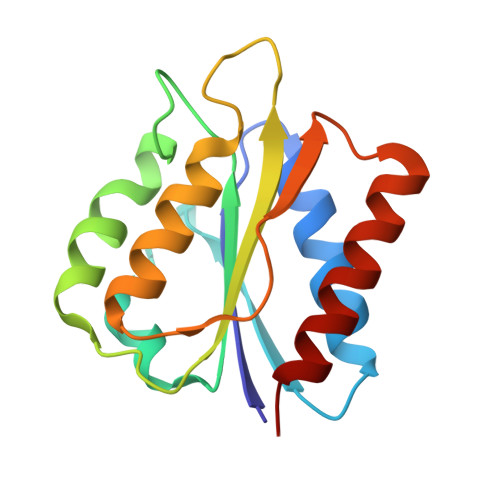High-resolution crystal structures reveal a mixture of conformers of the Gly61-Asp62 peptide bond in an oxidized flavodoxin from Bacillus cereus.
Gudim, I., Lofstad, M., van Beek, W., Hersleth, H.P.(2018) Protein Sci 27: 1439-1449
- PubMed: 29722453
- DOI: https://doi.org/10.1002/pro.3436
- Primary Citation of Related Structures:
6FSG, 6FSI, 6FT1 - PubMed Abstract:
Flavodoxins (Flds) are small proteins that shuttle electrons in a range of reactions in microorganisms. Flds contain a redox-active cofactor, a flavin mononucleotide (FMN), and it is well established that when Flds are reduced by one electron, a peptide bond close to the FMN isoalloxazine ring flips to form a new hydrogen bond with the FMN N5H, stabilizing the one-electron reduced state. Here, we present high-resolution crystal structures of Flavodoxin 1 from Bacillus cereus in both the oxidized (ox) and one-electron reduced (semiquinone, sq) state. We observe a mixture of conformers in the oxidized state; a 50:50 distribution between the established oxidized conformation where the peptide bond is pointing away from the flavin, and a conformation where the peptide bond is pointing toward the flavin, approximating the conformation in the semiquinone state. We use single-crystal spectroscopy to demonstrate that the mixture of conformers is not caused by radiation damage to the crystal. This is the first time that such a mixture of conformers is reported in a wild-type Fld. We therefore carried out a survey of published Fld structures, which show that several proteins have a pronounced conformational flexibility of this peptide bond. The degree of flexibility seems to be modulated by the presence, or absence, of stabilizing interactions between the peptide bond carbonyl and its surrounding amino acids. We hypothesize that the degree of conformational flexibility will affect the Fld ox/sq redox potential.
- Department of Biosciences, Section for Biochemistry and Molecular Biology, Department of Biosciences should be before Section for Biochemistry and Molecular Biology, University of Oslo, Oslo, Norway.
Organizational Affiliation:



















